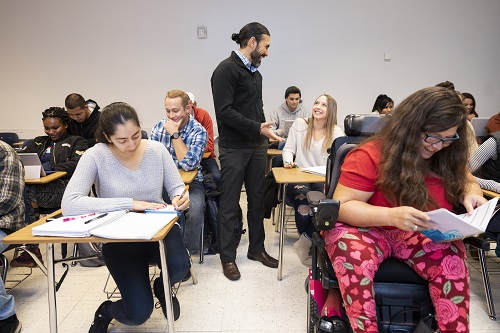Early Bird
Reasons and strategies for pronouncing students’ names correctly
Thirsty for a Strong Instructional Practice?
January 24, 2019
 At a diverse university such as Metropolitan State University of Denver, there is a good chance there will be student names on your class rosters that you will not recognize and may struggle to pronounce. Taking the time to learn the correct pronunciation of your students’ (and co-workers’) names is an effort that is easy to neglect in the crush of early-semester tasks. So why bother? Won’t they correct you? After all, it’s an honest mistake. Besides, aren’t they used to it with a name like that?
At a diverse university such as Metropolitan State University of Denver, there is a good chance there will be student names on your class rosters that you will not recognize and may struggle to pronounce. Taking the time to learn the correct pronunciation of your students’ (and co-workers’) names is an effort that is easy to neglect in the crush of early-semester tasks. So why bother? Won’t they correct you? After all, it’s an honest mistake. Besides, aren’t they used to it with a name like that?
Take a SIP of this: Pronouncing Students’ Names Correctly
Research shows there are several important reasons to correctly pronounce students’ names the first time and every time.
Names are pre-eminent symbols of our identity, family and culture. Students whose names are routinely mispronounced report feeling othered, ostracized and disrespected. Knowing and correctly pronouncing your students’ names shows respect, which studies (Delaney et al., 2010; Collaco, 2017) show affects student engagement and learning.
Still other educational scholars (e.g., Kohli and Solórzano, 2012) remind us that mispronunciations are not random mistakes. The names of students of color, especially those with nontraditional (i.e., non-Anglo, especially non-European names), are routinely mispronounced, reifying and normalizing an American classroom filled with Davids, Erics, Jennifers and Kathryns. Given a predominantly white faculty, routinely mispronouncing the names of students of color (or even worse, assigning nicknames) amounts to nothing less than racist microaggressions that leave students “believing that their culture or aspects of their identity are an inconvenience or are inferior.”” (p. 455).
Correctly pronouncing every student’s name not only avoids microaggressions in the classroom, it provides relief from discrimination that people with hard-to-pronounce names experience beyond the classroom (Lahman, Koval and Alter 2012).
While we all can’t all be orthoepists, we can take a few simple steps to ensure that we correctly pronounce students’ names.
- In the first weeks of class, take the time to have your students learn about one another’s names (see SIPs 8 Inclusive Classrooms, 2.1 Ice Breakers for ideas on how to facilitate this activity). Not only will this give the students an opportunity to learn and correctly pronounce each other’s names, it has the added benefit of creating a respectful and inclusive learning environment, which is linked to increases in student engagement and learning.
- Annotate your roster with phonetic spellings, mnemonic devices, pictures, etc. Or ask students to create name placards or badges that can be displayed during class.
- Challenge your students to correct you. Punita Rice writes that she tells her students, “Don’t allow me to say your name wrong. Keep correcting me until I get it. I want to respect the correct way to say your name.”
- Use one of several websites that allow you to input a name and hear how it is pronounced. Or simply search for the name online, and see if you can find its pronunciation. This can even be done before the first day of class, and just imagine how thrilled that student who never has their name pronounced correctly will be when you nail it on the first try!
Still Thirsty? Take another SIP of Pronouncing Students’ Names Correctly
General Information
- Mispronouncing Students’ Names: A Slight That Can Cut Deep
- Say Their Names (Correctly. From Day One. Always)
- The Lasting Impact of Mispronouncing Students’ Names
- Why Pronouncing Students’ Names Correctly Is Important
Academic References
- Collaço, Christine (2017) Increasing Student Engagement in Higher Education
- Delaney, J.G.; Johnson, A.N.; Johnson, T.D.; & Treslan, D.L. (2010) Students’ Perceptions of Effective Teaching in Higher Education
- Kohli and Solórzano (2012) Teachers, Please Learn Our Names!: Racial Microaggressions and the K-12 Classroom
- Lahman, Koval and Alter (2012) The Name-Pronunciation Effect: Why People Like Mr. Smith More Than Mr. Colquhoun
- Smyth, Ellen (2011) What Students Want: Characteristics of Effective Teachers from the Students’ Perspective.
Strategies & Resources
- Teachers’ Strategies for Pronouncing and Remembering Students’ Names Correctly
- My Name, My Identity … a program designed for K-12 but easily adapted to higher ed.
- Websites that help with pronunciation
Visit the Well for more great ideas and resources for Strong Instructional Practices in your higher-education classroom!
